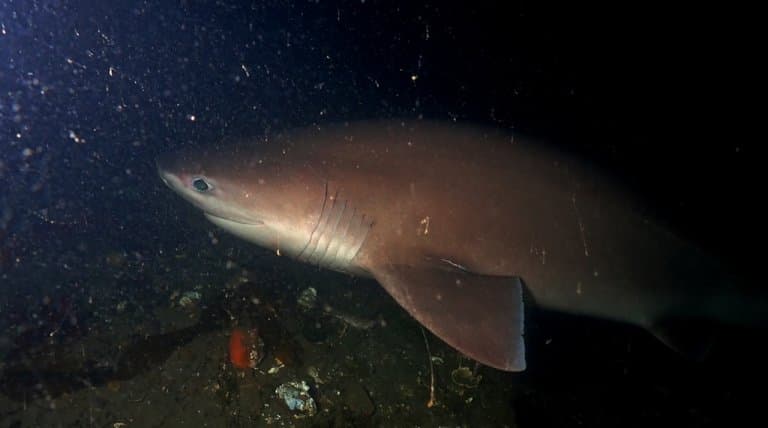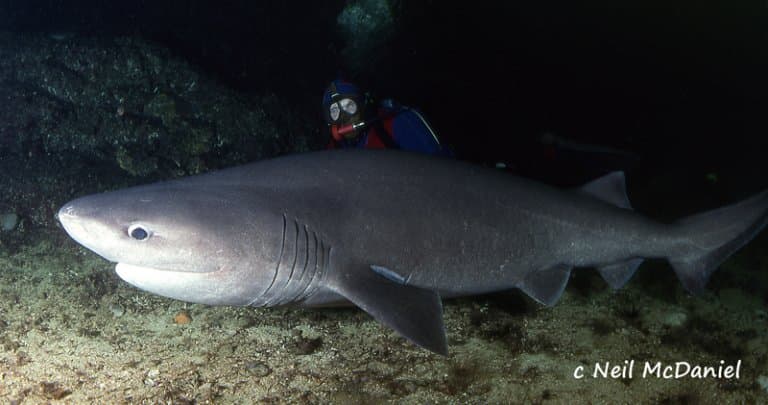Bluntnose Sixgill Shark Profile
The bluntnose sixgill shark is commonly known as the ‘cow shark’, and is a species of large deep-water shark.
It’s the largest primitive ‘hexanchoid’ shark growing up to 5.5 m (18 ft) in length, and is found in tropical and temperate waters around the world.
These sharks retain characteristics of their ancient lineage, that are unchanged from millions of years ago. Most sharks today only have five gill slits, rather than six, which gives its sixgill name.

Bluntnose Sixgill Shark Facts Overview
| Habitat: | Tropical and temperate waters, usually deeper than 100m |
| Location: | Global |
| Lifespan: | Unknown |
| Size: | Up to 5.5 m (18 ft) |
| Weight: | Up to 600 kg (1,300 lb) |
| Color: | Grey |
| Diet: | Fish, mammals |
| Predators: | Few; orca or larger sharks may feed on young in shallower waters |
| Top Speed: | Slow |
| No. of Species: |
1 |
| Conservation Status: |
Near threatened |
The bluntnose sixgill shark is a species of sixgill shark, which includes two other species – the bigeye sixgill shark, and the Atlantic sixgill shark.
Bluntnose sixgills are otherwise well-named ‘cow sharks‘ that reach to frightening proportions, especially if you happen to brush up against them in the deep ocean. They have a ‘blunt’ wide snout, from which it gets part of its name with beady green eyes.
They are a primitive species, and its closet living relatives outside of other sixgill and sevengill sharks, are the greenland shark, and dogfish. Some extinct relatives date back 200 million years.
Bluntnose sixgills spend their days close to the ocean floor, but are more buoyant than usual, and travel to the surfce at night to suck up or bite anything tasty. They drift north during the winter and and south in the summer due to seasonal movements of their prey.
They are a generalist species that feed nocturnally on a variety of food based upon its availability, such as fish, rays, squid, seals and other shark. They ambush prey and are able to prodtrude their jaws and tear food with 6 rows of saw-like teeth.
These are widespread and ancient sharks that we know relatively little about, but they’re still in danger of extinction through our destructive fishing practices.
Interesting Bluntnose Sixgill Facts
1. It’s a cow shark!
Cow sharks are members of the family Hexanchidae, which are thought to be some of the most primitive sharks left in existence. They have only one dorsal fin further back, and a face that looks like they’ve come out of a dinosaur book.
The species name griseus means grey, which is technically accurate but could describe many of the other species in the genus too.
Most sharks have five gill slits on each side, but the scientific name for these refers to their six gills, something which is found in most species in this genus (there are also members with seven).
They aren’t very reminiscent of cows at all, and they’re certainly not as cuddly. They’re antisocial and aggressive and their milk tastes terrible.

2. It’s a big shark!
At a (confirmed) length of 5.5 meters, this is one of the largest sharks in the ocean. It’s shorter only than the two plankton-eating monsters, as well as the Greenland shark and the Great White.
It’s also significantly longer than all cow species.
The largest on record is not likely to be the largest in the ocean, and since these sharks occupy some very deep waters all over the planet, there’s a chance an ancient monster is lurking down there somewhere that could compete with the White sharks for size. 1
3. They’ve been filmed attacking submarines
This size makes them formidable, even for submarines! A crew filming a whale carcass under 700 meters of the ocean came across a group of very large sharks they estimated at around six meters.
These sixgills were tearing into the carcass and squabbling over the food and aggressively defending it. They can be seen biting one another, chasing each other away, and at least one of them soon started bumping the submarine.
This scary encounter only lasted a while, and it seemed that once they realised the sub wasn’t there to steal their food, they settled down a bit. Still, the power and size of these sharks had the crew quite nervous.
4. They can float!
This might not seem like much for an animal that lives in water, but conventionally, positive buoyancy was something more commonly found in the bony fishes with swim bladders.
Most sharks are surprisingly dense and will sink if they don’t keep themselves actively afloat. They compensate for this density and lack of swim bladder with a very fatty liver, which does help somewhat, but in the case of Great Whites also attracts fat-hungry killer whales.
Since these sharks hunt from below, being able to flow up under your prey without wiggling around is a stealth advantage. And because they move up and down through the water column, rising from the cold depths is energy efficient when you can float.
Having spent time warming up in the 15-degree waters of 200 meters, they can then use that increase in metabolism to swim back down to their preferred depths of around 500 meters and below.
These sharks have been found further than 2km deep! 2
5. They’re suction feeders
Sharks catch prey in a variety of ways, the most familiar of all being the bite-you-in-half approach.
But while the bluntnose sixgill is capable of taking a meaty bite out of anything large enough, stomach contents of samples brought up from the depths show that a lot of their food is swallowed whole.
This suggests that, much like many bony fish, the bluntnose commonly feeds by sucking in smaller animals and swallowing without taking a single bite. 3
6. They’re one of the top predators in the trophic web
Trophic levels are scored out of a possible five points – five being the top predator, and a score rarely attributed to any animal, especially in the ocean.
To put it in perspective, Great Whites are ranked somewhere around 4.5, which puts them below Orcas, at around 4.6. Humans share a trophic level with pigs, between 2 and 3, which highlights a lot of the hypocrisy around how we treat them.
Bluntnose sixgills are no slouch, though. They’re ranked at 4.48, making them one of the ocean’s top predators. 4
7. They can give birth to over 100 pups
Like most sharks, they are ovoviviparous which means they develop embryos inside eggs that hatch inside the shark, giving birth to live young.
Litters for the bluntnose sixgill shark are large, with anywhere between 20-110 pups.
Little is known about their survival rate, but researchers presume they have a high mortality rate based upon their litter size.
These sharks reearch maturity between 11-35 years and can live up to 80 years.
8. They’re cosmopolitan!
These sharks are known as deep sea specialists, but the data suggests they’re equally familiar in the shallows. They’ve been found in water just 20-40 meters deep at certain times of the year, and they occupy waters all over the planet, too.
They’re found in both tropical and temperate water, and can obviously handle the frigid depths without issue.
They don’t seem to form big crowds either; instead preferring to spread out all over the place and make do with whatever they find.
And this is what makes them so successful. As generalist feeders, they’ll take on a whale carcass or suck up a small bony fish, and their ability to handle a variety of temperatures and depths allows them to go wherever they like.
These sharks have survived with very little modifications for around 200 million years. They’ve survived numerous extinctions, but populations are decreasing rapidly due to human fishing and they’re now listed as Near Threatened by the IUCN. 5
9. Sadly, they are near threatened
The IUCN currently lists the bluntnose six-gilled shark as ‘Near Threatened’, despite its range and obvious longevity. Although it’s often caught as a bycatch, it is also popular as a sport fish, which is thought to make it vulnerable.
Population numbers are difficult to obtain, but it’s thought they are higher in Europe due to the European Union’s broader limits on deep-sea shark fishing.
Like most shark species they are slow-growing and late maturing. Because of their poor reproduction, bluntnose six-gilled shark populations are under risk from both commercial and recreational fishing.

10. They are relatively harmless to humans
Despite their huge size, they are thought to be relatively harmless to humans.
Mature animals are elusive and often at deep sea, and immature sharks that are observed more regularly in shallower waters appear to tolerate and examine divers.
They can ‘snap’ if physical contact is pursued, but according to the International Shark Attack File, only one provoked attack has been reported since the 1500s by a bluntnose sixgill shark.
Bluntnose Sixgill Shark Fact-File Summary
Scientific Classification
| Kingdom: | Animalia |
| Phylum: | Chordata |
| Class: | Chondrichthyes |
| Order: | Hexanchiformes |
| Family: | Hexanchidae |
| Genus: | Hexanchus |
| Species Name: |
Hexanchus Griseus |
Fact Sources & References
- McClain CR, Balk MA, Benfield MC, Branch TA, Chen C, Cosgrove J, Dove AD, Gaskins L, Helm RR, Hochberg FG, Lee FB, Marshall A, McMurray SE, Schanche C, Stone SN, Thaler AD (2015), “Sizing ocean giants: patterns of intraspecific size variation in marine megafauna“, PMC.
- Itsumi Nakamura, Carl G. Meyer, Katsufumi Sato (2015), “Unexpected Positive Buoyancy in Deep Sea Sharks, Hexanchus griseus, and a Echinorhinus cookei“, PLOS One.
- Joseph J. Bizzarro, Aaron B. Carlisle, Wade D. Smith, Enric Cortés (2017), “Chapter Four – Diet Composition and Trophic Ecology of Northeast Pacific Ocean Sharks“, Advances in Marine Biology.
- Bizzarro, Joseph J et al (2017), “Diet Composition and Trophic Ecology of Northeast Pacific Ocean Sharks“, Advances in Marine Biology
- Grassmann, Michael et al (2017), “Sharks in Captivity: The Role of Husbandry, Breeding, Education, and Citizen Science in Shark Conservation“, Advances in Marine Biology.
